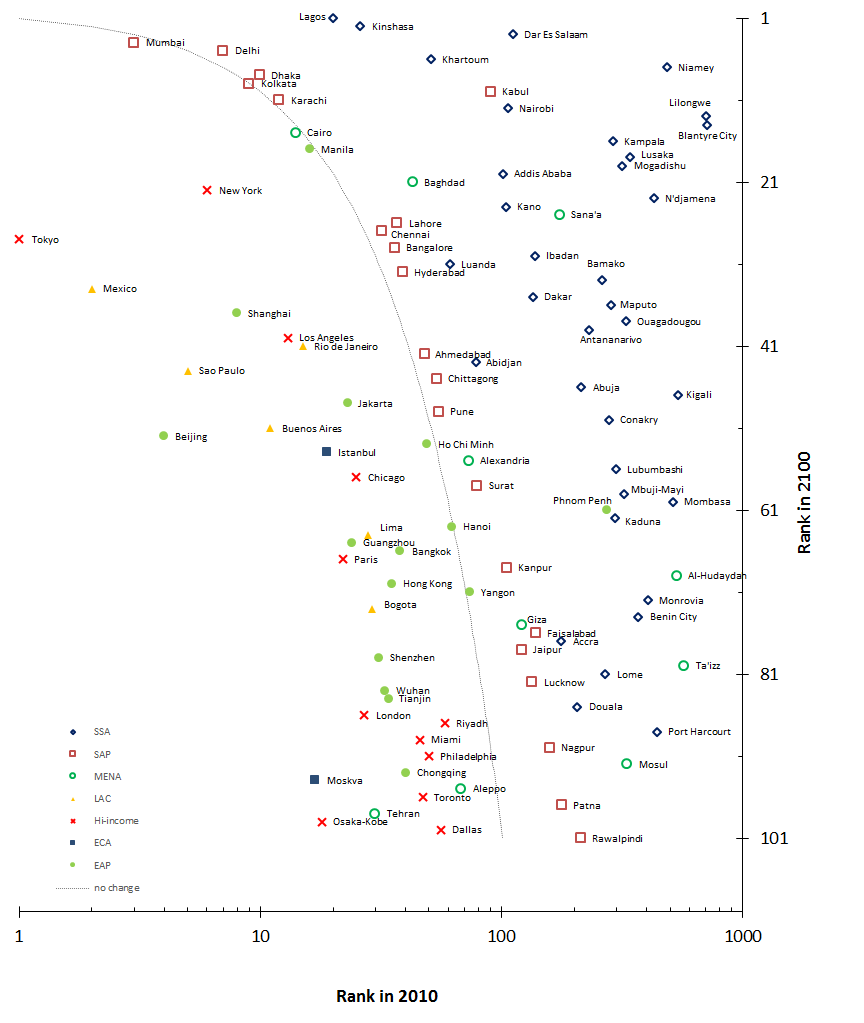The shifting power of cities
Posted by Daniel Hoornweg on October 03, 2016

Population predictions for the world’s largest cities in the 21st century (Part 2 of 2): New figures show the population of the world’s largest cities set to soar. This rapid growth calls for better, more sustainable cities.
Let’s assume you’re a policy advisor in a rich country; maybe the UK, US, Canada, Japan, France or China. You’re concerned with geopolitical trends and the relative power of your country into the future. You know that cities are the most important source of your country’s power (economic, cultural and military). And you know that cities are linked to the lion’s share of local and global environmental damage: cities and their residents are responsible for more than 80 per cent of the world’s greenhouse gas emissions.
Or let’s assume you’re a member of an NGO or think-tank working to reduce global poverty, and improve equity and life-chances for all. You know that cities, if built and managed well, can be your most powerful ally.
Faster urbanisation needs better cities
Findings from latest E&U brief suggests these groups need to work together and focus their efforts to establish sustainable cities in low-income countries, especially in South Asia and Africa whose cities are set for the highest rate of growth. The sooner this can be accomplished the faster humanity will reach a stable population and sustainable relationship with the planet.
How sustainable a path humanity follows will have a major impact on the global population -- varying from less than seven billion to over 13 billion by the end of the century. The lower figure is where the rapid urbanisation underway continues, particularly before 2050, and is combined with good progress towards sustainability – such as efforts to achieve development goals, less intense use of natural resources and cutting down on fossil fuels.
The rise of the low-income city
A massive shift in global population, and corresponding geopolitical power is underway. Cities in higher-income countries like Tokyo, New York, London, Paris, Toronto and Moscow are being eclipsed by fast-growing cities in lower-income countries.
Cities like Lagos, Dar es Salaam, Kinshasa, Mumbai, Dhaka, and Kabul are on track to each have populations in excess of 50 million. Much of the planet’s future health depends on the way these cities use resources and generate (and share) wealth.
The faster the geopolitical shift occurs, and the more sustainable cities are in emerging economies, the better for all. The best pathway for the rich OECD-led world is exactly the same for low-income, emerging economies: build better cities everywhere.
There is no question that today’s richer cities will secede power and influence to emerging cities this century (see table showing rapid growth of cities to the right of the line relative to those to the left). What is unknown is the pace of this shift, and the ratio of cooperation versus competition. Cities and their countries can either increase cooperation or competition for resources: the 20th century saw much competition for resources like oil and minerals; the 21st century will need to see more cooperation on how to work together to ameliorate environmental impacts and risks like Zika virus and climate change.
Benefitting future populations
The paper illustrates how the magnitude and timing of ‘peak population’ will be determined by the growth (and relative decline) of cities. By pursuing sustainability, the planet’s peak population can be reduced by more the six billion people, and the date when we reach the peak moved forward more than 40 years. This would bring enormous benefits to natural ecosystems and future populations.
Policy advisors wanting to promote healthy economic growth or NGOs seeking poverty reduction targets would be hard-pressed to find more powerful action than building more sustainable cities, at home and abroad.
Predicted rise of the 101 largest cities by 2100

This blog post is based on and Kevin Pope's forthcoming paper, Population predictions for the world’s largest cities in the 21st century, which will appear in an upcoming issue of Environment and Urbanization. The article is available free for download for a limited time online.
Filed under: Sustainability 101